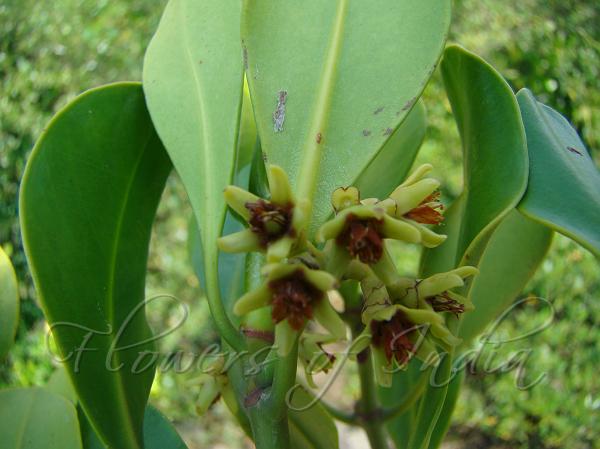|
| Tagal Mangrove |
|

|

| File size | 343568 |
| Original date | 9/24/09 12:15 PM |
| Resolution | 2048 x 1536 |
| Flash | Flash did not fire, auto |
| Focal length | 5.2mm |
| Exposure time | 1/250s |
| Aperture | 5.0 |
| Focus Distance | |
| Metering Mode | Multi-segment |
| Camera make | SONY |
| Camera model | DSC-H7 |
| Sensor type |
|
|
|
|
Photo: |
Botanical name: Ceriops tagal Family: Rhizophoraceae (Burma Mangrove family)
Tagal Mangrove is a small tree growing to 5–15 m in height, with many
"buttresses" at the base. The bark is dark red. The leaves are obovate to elliptical, 5–10 cm long, 2–6 cm wide, rounded and notched at tip, acute at base, entire, thick, leathery, glabrous, without visible veins. The
flowers are about 6 mm in length and are borne on short stalks. The sepals
are linear, with pointed tips. The petals are five, and smooth; tips
are flat or notched, with three or four club-shaped appendages. The
stamens are ten. The fruit is small, club-shaped or subovoid, and
surrounded near the base by the reflexed sepals.
Medicinal uses: The whole of the plant is believed to be rich
in an astringent principle. A decoction of the bark is used to stop
hemorrhages, and is applied to malignant ulcers. On the African Coast, a
decoction of the shoots is used as a substitute for quinine. Malays give a
decoction of the bark to women in childbirth. The bark is used in India as
a haemostatic.
The whole of the plant is believed to be rich
in an astringent principle. A decoction of the bark is used to stop
hemorrhages, and is applied to malignant ulcers. On the African Coast, a
decoction of the shoots is used as a substitute for quinine. Malays give a
decoction of the bark to women in childbirth. The bark is used in India as
a haemostatic.
Medicinal uses:
 The whole of the plant is believed to be rich
in an astringent principle. A decoction of the bark is used to stop
hemorrhages, and is applied to malignant ulcers. On the African Coast, a
decoction of the shoots is used as a substitute for quinine. Malays give a
decoction of the bark to women in childbirth. The bark is used in India as
a haemostatic.
The whole of the plant is believed to be rich
in an astringent principle. A decoction of the bark is used to stop
hemorrhages, and is applied to malignant ulcers. On the African Coast, a
decoction of the shoots is used as a substitute for quinine. Malays give a
decoction of the bark to women in childbirth. The bark is used in India as
a haemostatic. | Identification credit: Chandrashekhar Marathe | Photographed at Palghar & Gorai creek, Maharashtra. |
• Is this flower misidentified? If yes,